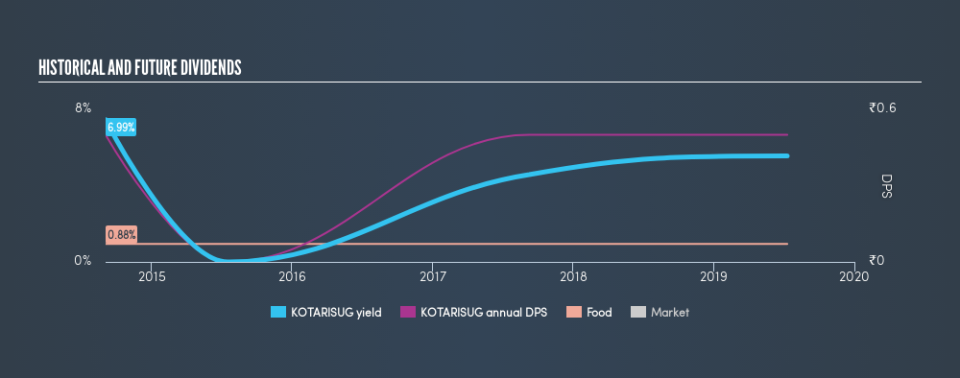Why Kothari Sugars and Chemicals Limited (NSE:KOTARISUG) Is A Dividend Rockstar

Want to participate in a short research study? Help shape the future of investing tools and you could win a $250 gift card!
Today we'll take a closer look at Kothari Sugars and Chemicals Limited (NSE:KOTARISUG) from a dividend investor's perspective. Owning a strong business and reinvesting the dividends is widely seen as an attractive way of growing your wealth. Unfortunately, it's common for investors to be enticed in by the seemingly attractive yield, and lose money when the company has to cut its dividend payments.
In this case, Kothari Sugars and Chemicals likely looks attractive to dividend investors, given its 5.2% dividend yield and five-year payment history. We'd agree the yield does look enticing. Some simple research can reduce the risk of buying Kothari Sugars and Chemicals for its dividend - read on to learn more.
Explore this interactive chart for our latest analysis on Kothari Sugars and Chemicals!
Payout ratios
Companies (usually) pay dividends out of their earnings. If a company is paying more than it earns, the dividend might have to be cut. Comparing dividend payments to a company's net profit after tax is a simple way of reality-checking whether a dividend is sustainable. In the last year, Kothari Sugars and Chemicals paid out 33% of its profit as dividends. A medium payout ratio strikes a good balance between paying dividends, and keeping enough back to invest in the business. Besides, if reinvestment opportunities dry up, the company has room to increase the dividend.
Is Kothari Sugars and Chemicals's Balance Sheet Risky?
As Kothari Sugars and Chemicals has a meaningful amount of debt, we need to check its balance sheet to see if the company might have debt risks. A quick check of its financial situation can be done with two ratios: net debt divided by EBITDA (earnings before interest, tax, depreciation and amortisation), and net interest cover. Net debt to EBITDA measures total debt load relative to company earnings (lower = less debt), while net interest cover measures the ability to pay interest on the debt (higher = greater ability to pay interest costs). With net debt of 2.02 times its EBITDA, Kothari Sugars and Chemicals has a noticeable amount of debt, although if business stays steady, this may not be overly concerning.
We calculated its interest cover by measuring its earnings before interest and tax (EBIT), and dividing this by the company's net interest expense. With EBIT of 4.46 times its interest expense, Kothari Sugars and Chemicals's interest cover is starting to look a bit thin.
Consider getting our latest analysis on Kothari Sugars and Chemicals's financial position here.
Dividend Volatility
From the perspective of an income investor who wants to earn dividends for many years, there is not much point buying a stock if its dividend is regularly cut or is not reliable. Kothari Sugars and Chemicals has been paying a dividend for the past five years. Its most recent annual dividend was ₹0.50 per share, effectively flat on its first payment five years ago.
We're glad to see the dividend has risen, but with a limited rate of growth and fluctuations in the payments, we don't think this is an attractive combination.
Dividend Growth Potential
Examining whether the dividend is affordable and stable is important. However, it's also important to assess if earnings per share (EPS) are growing. Growing EPS can help maintain or increase the purchasing power of the dividend over the long run. Strong earnings per share (EPS) growth might encourage our interest in the company despite fluctuating dividends, which is why it's great to see Kothari Sugars and Chemicals has grown its earnings per share at 29% per annum over the past five years. Earnings per share have rocketed in recent times, and we like that the company is retaining more than half of its earnings to reinvest. However, always remember that very few companies can grow at double digit rates forever.
Conclusion
Dividend investors should always want to know if a) a company's dividends are affordable, b) if there is a track record of consistent payments, and c) if the dividend is capable of growing. First, we like that the company's dividend payments appear well covered, although the retained capital also needs to be effectively reinvested. We were also glad to see it growing earnings, but it was concerning to see the dividend has been cut at least once in the past. All things considered, Kothari Sugars and Chemicals looks like a strong prospect. At the right valuation, it could be something special.
See if management have their own wealth at stake, by checking insider shareholdings in Kothari Sugars and Chemicals stock.
Looking for more high-yielding dividend ideas? Try our curated list of dividend stocks with a yield above 3%.
We aim to bring you long-term focused research analysis driven by fundamental data. Note that our analysis may not factor in the latest price-sensitive company announcements or qualitative material.
If you spot an error that warrants correction, please contact the editor at editorial-team@simplywallst.com. This article by Simply Wall St is general in nature. It does not constitute a recommendation to buy or sell any stock, and does not take account of your objectives, or your financial situation. Simply Wall St has no position in the stocks mentioned. Thank you for reading.


